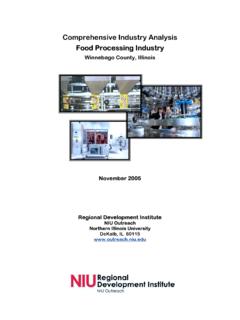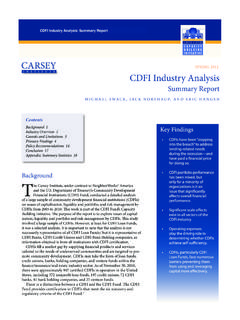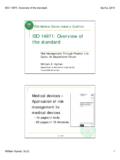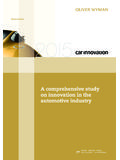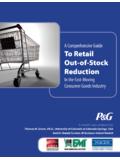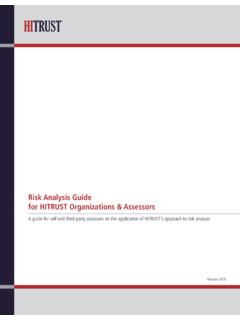Transcription of Seafood traceability systems: gap analysis of ...
1 FAO Fisheries and Aquaculture Circular FIAM/C1123 (En) ISSN 2070-6065 Seafood traceability SYSTEMS: GAP analysis OF inconsistencies IN standards AND NORMS FAO Fisheries and Aquaculture Circular No. 1123 FIAM/C1123 (En) Seafood traceability SYSTEMS: GAP analysis OF inconsistencies IN standards AND NORMS Melania Borit Postdoctoral Fellow University of Tromso Tromso, Norway Petter Olsen Senior Scientist NOFIMA Tromso, Norway FOOD AND AGRICULTURE ORGANIZATION OF THE UNITED NATIONS Rome, 2016 The designations employed and the presentation of material in this information product do not imply the expression of any opinion whatsoever on the part of the Food and Agriculture Organization of the United Nations (FAO) concerning the legal or development status of any country, territory, city or area or of its authorities, or concerning the delimitation of its frontiers or boundaries. The mention of specific companies or products of manufacturers, whether or not these have been patented, does not imply that these have been endorsed or recommended by FAO in preference to others of a similar nature that are not mentioned.
2 The views expressed in this information product are those of the author(s) and do not necessarily reflect the views or policies of FAO. ISBN 978-92-5- 109337-5 FAO, 2016 FAO encourages the use, reproduction and dissemination of material in this information product. Except where otherwise indicated, material may be copied, downloaded and printed for private study, research and teaching purposes, or for use in non-commercial products or services, provided that appropriate acknowledgement of FAO as the source and copyright holder is given and that FAO s endorsement of users views, products or services is not implied in any way. All requests for translation and adaptation rights, and for resale and other commercial use rights should be made via or addressed to FAO information products are available on the FAO website ( ) and can be purchased through iii PREPARATION OF THIS DOCUMENT FAO member countries requested a study on gap analysis of Seafood traceability systems and stipulated the parameters in paragraph 38 of the Report of the thirteenth session of the Sub-Committee on Fish Trade (COFI:FT), held in Hyderabad, India in February 2012.
3 This research was completed by two expert consultants, under the supervision of Victoria Chomo, Fishery Officer, Fisheries and Aquaculture Policy and Resources Division, FAO and was presented as an Information Note (English only) to the fifteenth session of COFI:FT in Agadir, Morocco, in February 2016. Member countries expressed satisfaction with the results of this research and it was decided by the COFI:FT Secretariat to disseminate these key findings and recommendations more widely through an FAO Circular. iv FAO. 2016. Seafood traceability systems: gap analysis of inconsistencies in standards and norms, by Melania Borit and Petter Olsen. Fisheries and Aquaculture Circular No. 1123. Rome, Italy. ABSTRACT FAO member countries requested a study on gap analysis of Seafood traceability systems and stipulated the parameters in paragraph 38 of the Report of the thirteenth session of the Sub-Committee on Fish Trade (COFI:FT), held in Hyderabad, India, in February 2012.
4 This research was completed by two expert consultants and initially presented as an Information Note to the fifteenth session of COFI:FT in Agadir, Morocco, in February 2016. The report identifies and analyses gaps and inconsistencies in the current traceability standards and regulations worldwide, taking into account the following traceability specifications requested by member countries, namely: (i) how the integrity of product tracking is maintained; (ii) special consideration for developing countries and small-scale fisheries; (iii) the notion of equivalency; and (iv) the notion of harmonization. The key terms in understanding the concept of traceability are explained. The authors note that previous analysis of Seafood traceability practices identified three main categories of traceability standards and regulations that this analysis follows: international standards and guidelines; regulatory standards and industry and NGO non-regulatory standards .
5 This analysis employs a multi-methods approach from a multi- and interdisciplinary perspective, which involves the following steps: (i) conceptualization of key terms; (ii) a comprehensive literature review; (iii) a gap analysis ; and (iv) a content analysis . According to the authors, Seafood traceability approaches remain underdeveloped and fractured across geographies, jurisdictions and market sectors. The gaps in Seafood traceability systems identified in this analysis are: awareness, commitment, implementation, technology and standards . The authors include recommendations on how to address each of these traceability gaps. v CONTENTS Preparation of this document iii Abstract iv Abbreviations and acronyms vi Executive Summary vii 1. Background 1 2. Methodology 2 General considerations 2 Gap analysis 2 Concept, types of gaps and approach of this study 2 Literature review 3 3. Theoretical framework 5 traceability and traceability systems 5 traceability concept, terms and definitions 5 traceability systems 9 Drivers of traceability systems 10 traceability and transparency 12 traceability and chain of custody 12 traceability and catch/trade documentation schemes 13 traceability and analytical methods 13 traceability and data validation and verification 14 Harmonization and standardization 14 Consistency 15 4.
6 Overview of existing traceability standards and regulations 17 International standards and guidelines 17 The Codex Alimentarius 17 The International Office of Epizootics 17 FAO guidelines 18 RFMO catch/trade documentation schemes 18 Regulations 18 European Union (Member Organization) 18 United States of America 19 Japan 20 Non-regulatory standards 20 International Organization for Standardization 20 Industry 20 Non-governmental organizations 21 5. Gap analysis results 22 Gaps 22 inconsistencies 23 Intra-institutional inconsistency 23 Inter-institutional inconsistency 24 6. Conclusions 25 7. Recommendations 26 8.
7 References 27 vi ACRONYMS AND ABBREVIATIONS CoC chain of custody COFI:FT Committee on Fisheries Sub-Committee on Fish Trade CTDS catch/trade documentations scheme EDI Electronic Data Interchange EU European Union GFL General Food Law IPOA-IUU International Plan of Action to Prevent, Deter and Eliminate Illegal, Unreported and Unregulated Fishing ISO International Organization for Standardization IUU illegal, unreported and unregulated (fishing) FAO Food and Agriculture Organization of the United Nations FSMA Food Safety Modernization Act NGO non-governmental organization OIE World Organisation for Animal Health (former International Office of Epizootics) RF-ID radio-frequency identification RFMO Regional Fisheries Management Organization TRU traceable resource unit TU trade unit XML extensible Markup Language vii EXECUTIVE SUMMARY This study was commissioned to identify and analyse gaps and inconsistencies in the current traceability standards and regulations, by taking into account the following traceability specifications: (i) how the integrity of product tracking is maintained; (ii) special consideration for developing countries and small-scale fisheries; (iii) the notion of equivalency; and (iv) the notion of harmonization.
8 As a first step in reaching this goal, the key terms in understanding the concept of traceability were explained ( granularity, transformations, referential integrity), which was described in connection with related notions ( traceability systems, transparency, analytical methods).The second step consisted in performing a comprehensive literature review that served as a basis for building the gap analysis of the traceability standards and regulations. The last step consisted in performing a content analysis of selected international standards and guidelines, regulatory standards , and industry and non-governmental organizations (NGOs) non-regulatory standards . By employing this multi-method analysis , several awareness, commitment, implementation, technology and standards gaps were identified and described. In addition, specific inconsistencies of inter- and intra-institutions were highlighted.
9 Recommendations discussed include: Increase awareness of what traceability is, how it is different from other similar concepts, how traceability may add value to a company and a business. Develop a self-assessment scheme for Seafood traceability where the advantages and disadvantages of each alternative are clearly spelled out and recommendations are made concerning which selections belong together. Raise awareness about the utility of using standards . Support various levels of complexity and allow a certain degree of variety and of freedom of choice with respect to implementing traceability . 1 1. BACKGROUND During the Fourteenth Session of the FAO Sub-Committee on Fish Trade (COFI:FT) held in Bergen, Norway, in February 2014, the member countries requested further work on the analysis of current traceability practices, namely, a gap analysis of Seafood traceability systems. This study builds on this request, and is in line with the COFI:FT terms of references: provides a brief overview of existing traceability standards and regulations as summarized in Andre (2013); provides detailed identification of gaps and inconsistencies in the current standards and regulations, taking into consideration the following traceability specifications: o how the integrity of product tracking is maintained; o special consideration for developing countries and small-scale fisheries; o the notion of equivalency; o the notion of harmonization; includes practical recommendations for improving transparency and standardization of Seafood traceability systems to reduce costs in the international marketplace, especially for developing countries and economies-in-transition seeking market access.
10 Section 2 explains the methodology followed by this study and Section 3 defines the core concepts used here. Section 4 briefly describes the international standards and guidelines, regulatory standards , and industry and non-governmental organizations (NGOs) non-regulatory standards included in the analysis . Section 5 presents the results of the gap analysis . Following the concluding remarks in Section 6, recommendations are made in Section 7. 2 2. METHODOLOGY General considerations To address the complexity of its aims, this study employed a multi-methods approach from a multi- and interdisciplinary perspective, which involved the following steps: 1. Conceptualization of key terms; 2. A comprehensive literature review; 3. A gap analysis of the traceability standards and regulations; 4. A content analysis of selected international standards and guidelines, regulatory standards , and industry and NGO non-regulatory standards . Gap analysis Concept, types of gaps and approach of this study A gap analysis determines the space between where something is and where it is desired to be.










